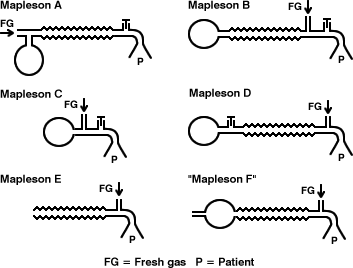 |
||||||||||||||||||||||
|
|
|
Non-rebreathing Circuits The distinguishing feature of non-rebreathing circuits is that elimination of carbon dioxide is accomplished by removing all expired gases from the system and venting them to atmosphere. This is normally achieved by using the fresh gas flow from the anesthetic machine to direct the expired gases out of the circuit via a valve or other arrangement. In general, non-rebreathing systems provide good control of the inspired gas concentrations, since fresh gas delivered from the anesthetic machine is inspired in each breath. They are, however, are less economical in use than rebreathing systems because the minute volume of ventilation (or more) must be supplied to the patient to prevent rebreathing, and they contribute more to the problem of atmospheric pollution with anesthetic agents. They are also less forgiving of operator error since an inadequate fresh gas supply will result in rebreathing Mapleson's Classification of Non-rebreathing Circuits Mapleson's classification divides non-rebreathing circuits into functionally similar groups, on the basis of the fresh gas flow required to prevent rebreathing and the ease with which intermittent positive pressure ventilation may be performed.
Mapleson
A - the Magill and Lack
circuits The Humphrey ADE is a new circuit that provides the ability to switch between the Mapleson A, D and E arrangements. Non-standard
circuits |
Comments
on this article should be addressed to Dr
Guy Watney
All pages © Anesthesia Service
and Equipment 1998-2003.
